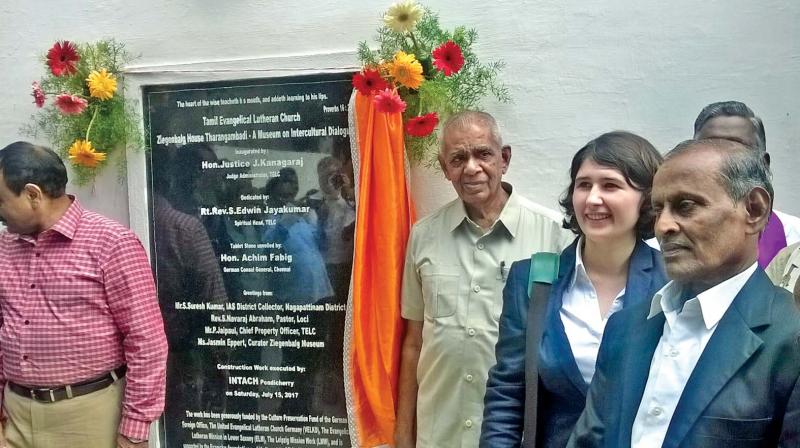Bartholomaeus Ziegenbalg house now a museum

Tranquebar: Ozone-filled sea breeze wafted across the house. A choir of girl students sang in praise of Jesus and Christian missionaries. Amidst a festive mood, the 'Zeigenbalg Museum on Intercultural Dialogue' was inaugurated at Tharagampadi, once a Danish settlement, on the Bay of Bengal in Nagapattinam district, on Saturday.
This is one of the landmark events in the history of Tharangampadi or Tranquebar as the quaint coastal place is known, declared those who attended the function. While Justice J. Kanagaraj, Judge, Administrator, Tamil Evangelical Lutheran Church (TELC) inaugurated the museum, Lisa Eichhorn, Consular Attache, Consulate General of the Federal Republic of Germany, Chennai unveiled the stone. Prof. D.Kamal Chopra, president, All India Federation of Master Printers inaugurated the exhibition.
A German missionary Bartholomaeus Ziegenbalg landed at Tharangampadi, described as the land of singing waves on July 9 in 1706. He purchased the house and spent many creative hours of his life in it till his death in 1719.
The contributions of Ziegenbalg to society are many. Within a short span of time he was able to master the Tamil language and also set up the first Tamil Printing Press in 1712.
Opening of educational institutions for Tamil children, bringing out the first comprehensive translation of Bible and its distribution are some of his contributions.
The house where he lived has now been converted into a museum after restoration. The historical significance of the museum is that it is an important monument of Indo-German heritage.
The speakers at the function said that the museum is a joint project by TELC in close cooperation with the Evangelical Lutheran Mission in Lower Saxony, the Francke Foundations Halle, and the Leipzig Mission work.
The restoration work was generously funded by the cultural preservation fund of the German Federal Foreign Office and the United Evangelical-Lutheran Church in Germany (VELKD).
The work was professionally executed and co-coordinated by Indian National Trust for Art and Cultural Heritage (INTACH) and local craftsmen. The 'Baptism bawl' of Ziegenbalg brought from Pulsaitz to Tharangampadi in 1934, Oversize print of songs (devotional songs), old printing machines, photos of print workshops held at Tharangampadi at various years, print letters are among the display in the museum.
The German government has contributed Rs 36 lakh in Indian currency for the project. According to the project managers, for the time being, the museum concentrates on the impact of Tamil printing history exhibiting machines and accessories from 19th century. Salem District Printers Association and All India Federation of Master Printers have contributed to the museum.
In the course of time, when security standards are met, Original documents from 18th century, housed in the archives in Halle, Germany, Copenhagen, Denmark, and London, United Kingdom, will be displayed in the museum and made available to the members of the public. The museum will then be expanded into a research house.

